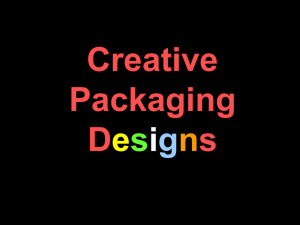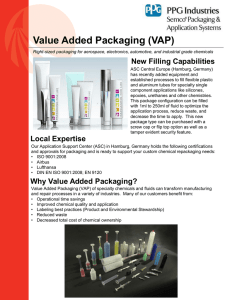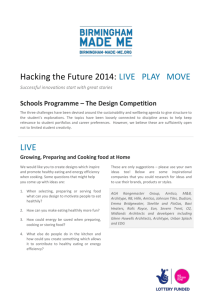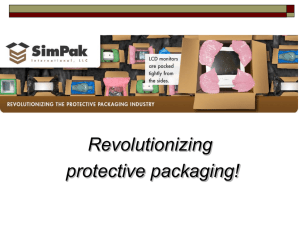packaging - Zoe-s-wiki
advertisement
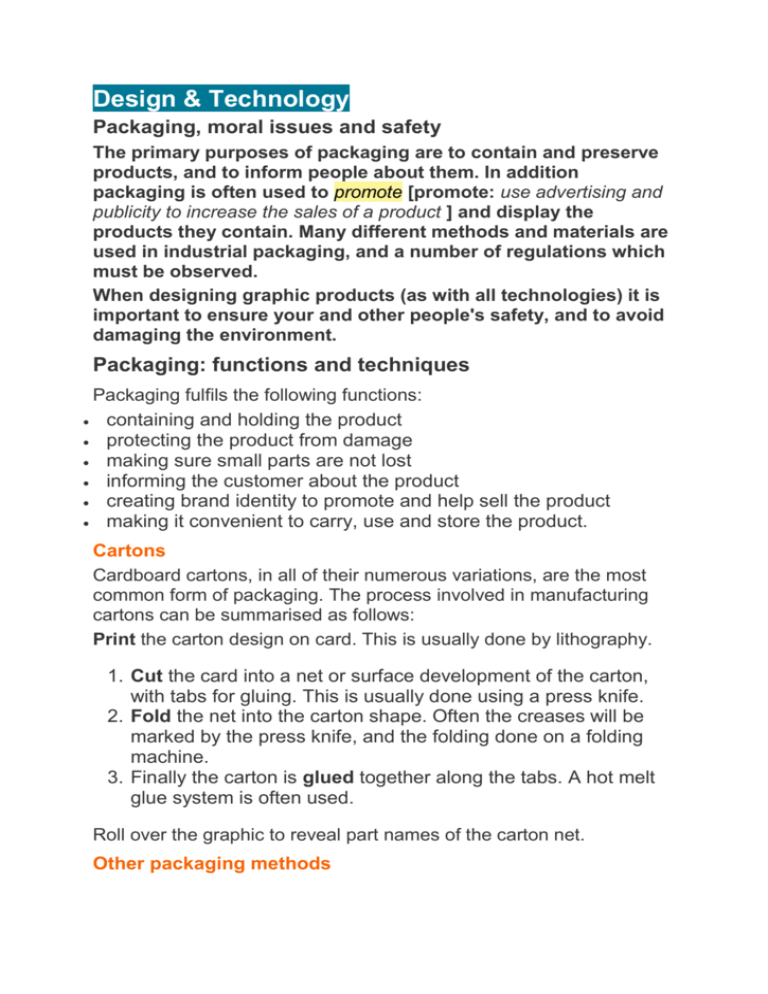
Design & Technology Packaging, moral issues and safety The primary purposes of packaging are to contain and preserve products, and to inform people about them. In addition packaging is often used to promote [promote: use advertising and publicity to increase the sales of a product ] and display the products they contain. Many different methods and materials are used in industrial packaging, and a number of regulations which must be observed. When designing graphic products (as with all technologies) it is important to ensure your and other people's safety, and to avoid damaging the environment. Packaging: functions and techniques Packaging fulfils the following functions: containing and holding the product protecting the product from damage making sure small parts are not lost informing the customer about the product creating brand identity to promote and help sell the product making it convenient to carry, use and store the product. Cartons Cardboard cartons, in all of their numerous variations, are the most common form of packaging. The process involved in manufacturing cartons can be summarised as follows: Print the carton design on card. This is usually done by lithography. 1. Cut the card into a net or surface development of the carton, with tabs for gluing. This is usually done using a press knife. 2. Fold the net into the carton shape. Often the creases will be marked by the press knife, and the folding done on a folding machine. 3. Finally the carton is glued together along the tabs. A hot melt glue system is often used. Roll over the graphic to reveal part names of the carton net. Other packaging methods Bottles and jars made from glass or plastic are used for liquids, granules and powders. Boxes and cylinders made from card are also used for granules, powders and whole items. Plastic bags are used for food products and small loose items, eg snack foods and sweets. Cans are used for food products. Drinks cans are made from aluminium and food cans are made from tin-coated steel (tinplate). Bubble packs consisting of a stiff plastic bubble made by vaccuum-forming fixed to a card backing - are used for small products, eg stationery items, toys and screws. Shrink-wrapping - soft plastic vaccuum formed onto card backing - is used for some small products, eg DIY products and toys. Packaging: regulation Commercial product packaging is regulated by a large number of laws [laws: formal rules adopted by Parliament and enforced by government ] and standards [standards: guidelines or specifications which are widely agreed and commonly accepted, but do not necessarily have the force of law ]. Some of the most important principles are that: the name of the company that made the product should be visible on the packaging the contents of the product (and its packaging) should be listed health and safety information about using the product should be given. The pack should warn about any possible hazards [hazards: anything likely to cause harm and/or damage ] from the product information about safely disposing of the packaging or container after use should be given a bar code should be displayed for stock control and pricing purposes, and instructions for recycling the product and/or its packaging after use should be included Foodstuff packaging is required by law to display information about the package contents Special regulations apply to packaging of food under UK and EU law. All food packaging must include the following information: the food name and description the manufacturer's name and address the weight or amount of the contents a list of ingredients nutritional information preparation instructions storage instructions, and the country of origin Moral issues All products have an impact on the environment, and graphic products are no exception. In particular their production may contribute to deforestation and their disposal to waste pollution. Designers have a responsibility to think about moral issues like these. Environmental considerations Raw materials: paper and card are made from cellulose fibre normally obtained from wood, old rags or old paper. If made from wood, care needs to be taken to ensure that the wood is from sustainable forests. The processes of paper-making may produce waste products. Manufacturing: inks and solvents used in graphic products manufacturing processes may be harmful unless used and disposed of correctly. Products: graphic products and their packaging can be the cause of large amounts of waste pollution if simply thrown away or dumped in landfill sites. Virtually all kinds of graphics waste however can be usefully recycled. From THIS - forestry logs at a paper mill to THIS - waste paper mountain at a recycling plant Cultural issues Designers should be sensitive to the fact that certain sorts of images and text on graphic products can cause offence to certain groups of people - eg those from minority religious traditions or cultures. Special care needs to be taken in the case of images/text that are on public view, such as advertisements. Global media and mass travel means that other cultures' rich and diverse heritage of graphic images and styles is increasingly available to designers everywhere, and often are the inspiration for new design ideas. Health and safety All those who are involved in designing and making products have a responsibility for minimising the risk of harm to themselves or to others. Any activity or substance or tool that could potentially cause harm or damage is a hazard, and risk assessment is the process of identifying the hazards that could arise in a particular situation, and the risk of someone being hurt by them - so that steps can be taken to reduce that risk. 1. During designing and making a product, ask yourself the following questions: could any of the materials used cause harm to the maker or others? might any of the intended processes cause harm to the maker or others? could any of finishing techniques cause harm to the maker or others? 2. When a product is finished, ask yourself the following questions: will the product be strong enough to support any loads involved? could there be any adverse effects on users: toxic, harmful, etc? are the materials suitable for the purpose, and safe for users? have all hazards been sufficiently guarded: electrical insulation, moving parts, folding components, etc? 3. When a product is being disposed of, ask yourself the following questions: can the components and materials be dismantled without harm? could dismantling result in the release of toxic or harmful substances? will recycling of materials, for example melting down, cause the release of toxic or harmful substances? If the answers to any of these questions lead you think that harm may be caused, that aspect of the product should be redesigned to reduce the risk. Cutting tools and safety When using cutting tools to cut card or board (eg for making models) the risk of injury will be minimised if you follow the guidelines in the table. Cutting tools and safety precautions Material Use these tools Take these precautions Card Craft knife; scissors; cutting mat; safety ruler Store craft knives safely with blades covered; carry knives and scissors carefully; always use a safety ruler and a cutting mat Foam board; styrene sheet; corrugated plastic Craft knife; cutting mat; safety ruler; snips Store and carry craft knives safely; always use safety ruler and cutting mat; make sure snips are sharp and store snips safely Styrofoam [styrofoam: a special high-density polystyrene foam board. ]; mediumdensity fibreboard To cut Styrofoam use tenon saw; coping saw; craft knife; safety ruler; jigsaw; band saw (teachers only); For MDF: tenon saw; wood chisel; bench hook, jigsaw; band saw (teachers only) Hold work firmly in vice or clamp; use cutting tools correctly and keep hand behind the cutting edge; use dust extraction and wear eye protection when using the jigsaw Now try a Test Bite Back to Revision Bite

